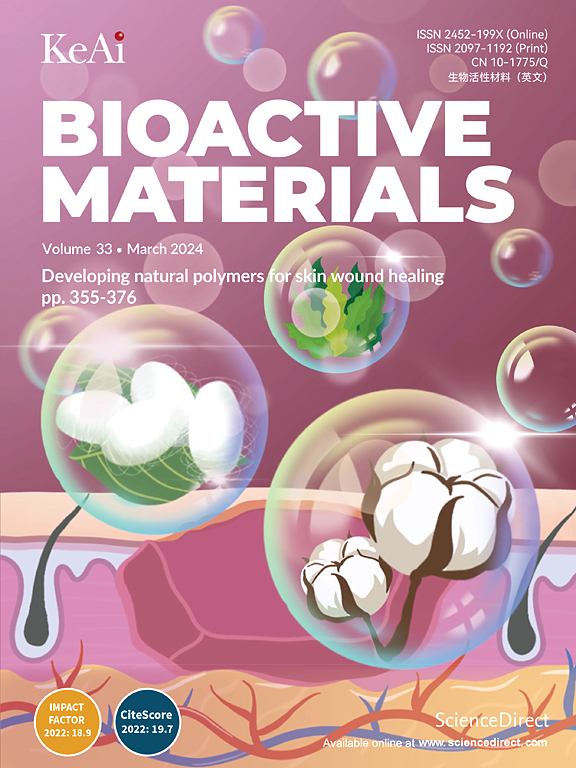Exosomes from young plasma stimulate the osteogenic differentiation and prevent osteoporosis via miR-142-5p
IF 18
1区 医学
Q1 ENGINEERING, BIOMEDICAL
引用次数: 0
Abstract
Osteoporosis (OP) is a multifactorial metabolic bone disorder commonly observed in the elderly, particularly prevalent in postmenopausal women. However, many conventional anti-osteoporosis drugs have undesirable side effects, limiting their long-term use. Here, we demonstrated that exosomes derived from both young and old healthy human plasma, which exhibited similar morphology, could significantly enhance the proliferation and migration of mesenchymal stem cells (MSCs). Furthermore, treatment with these exosomes increased alkaline phosphatase (ALP) activity, enhanced the mineralization of MSCs, and decreased the number of osteoclasts in vitro. When intravenously injected into rats, these exosomes accumulated in bone tissue. In vivo experiments demonstrated that both types of exosomes had a beneficial effect on osteoporosis by facilitating bone formation and suppressing osteoclast differentiation in an ovariectomized (OVX)-induced osteoporotic rat model. Strikingly, exosomes derived from young healthy human plasma exhibited stronger anti-osteoporosis effect. The miRNA sequencing analysis showed that miR-142-5p expression was significantly higher in the exosomes from young healthy adult plasma compared to in exosomes from older controls. Importantly, miR-142-5p overexpression exerted similar pro-osteogenic effects to those of exosomes from young healthy human plasma, while miR-142-5p downregulation had the opposite effect on osteogenic differentiation of MSCs. The anti-osteoporosis effect of exosomes from young healthy adult plasma were reversed upon miR-142-5p inhibition. In addition, ZFPM2 was a potential target of miR-142-5p involved in osteoporosis. Therefore, our study reveals the potential anti-osteoporosis effects of plasma exosomes and their underlying mechanisms, thereby providing an effective therapeutic strategy for clinical treatment of osteoporosis.

来自年轻血浆的外泌体通过miR-142-5p刺激成骨分化并预防骨质疏松
骨质疏松症(OP)是一种多因素代谢性骨骼疾病,常见于老年人,尤其常见于绝经后妇女。然而,许多传统的抗骨质疏松药物有不良的副作用,限制了它们的长期使用。在这里,我们证明了来自年轻和年老健康人血浆的外泌体具有相似的形态,可以显著增强间充质干细胞(MSCs)的增殖和迁移。此外,这些外泌体增加了碱性磷酸酶(ALP)活性,增强了MSCs的矿化,并减少了体外破骨细胞的数量。当静脉注射到大鼠体内时,这些外泌体在骨组织中积累。体内实验表明,在去卵巢(OVX)诱导的骨质疏松大鼠模型中,两种类型的外泌体通过促进骨形成和抑制破骨细胞分化对骨质疏松症有有益作用。引人注目的是,来自年轻健康人类血浆的外泌体表现出更强的抗骨质疏松作用。miRNA测序分析显示,来自年轻健康成人血浆的外泌体中miR-142-5p的表达明显高于来自老年对照组的外泌体。重要的是,miR-142-5p过表达与来自年轻健康人血浆的外泌体具有相似的促成骨作用,而miR-142-5p下调对MSCs的成骨分化具有相反的作用。年轻健康成人血浆外泌体的抗骨质疏松作用在miR-142-5p抑制后被逆转。此外,ZFPM2是参与骨质疏松的miR-142-5p的潜在靶点。因此,我们的研究揭示了血浆外泌体潜在的抗骨质疏松作用及其潜在机制,从而为骨质疏松症的临床治疗提供有效的治疗策略。
本文章由计算机程序翻译,如有差异,请以英文原文为准。
求助全文
约1分钟内获得全文
求助全文
来源期刊

Bioactive Materials
Biochemistry, Genetics and Molecular Biology-Biotechnology
CiteScore
28.00
自引率
6.30%
发文量
436
审稿时长
20 days
期刊介绍:
Bioactive Materials is a peer-reviewed research publication that focuses on advancements in bioactive materials. The journal accepts research papers, reviews, and rapid communications in the field of next-generation biomaterials that interact with cells, tissues, and organs in various living organisms.
The primary goal of Bioactive Materials is to promote the science and engineering of biomaterials that exhibit adaptiveness to the biological environment. These materials are specifically designed to stimulate or direct appropriate cell and tissue responses or regulate interactions with microorganisms.
The journal covers a wide range of bioactive materials, including those that are engineered or designed in terms of their physical form (e.g. particulate, fiber), topology (e.g. porosity, surface roughness), or dimensions (ranging from macro to nano-scales). Contributions are sought from the following categories of bioactive materials:
Bioactive metals and alloys
Bioactive inorganics: ceramics, glasses, and carbon-based materials
Bioactive polymers and gels
Bioactive materials derived from natural sources
Bioactive composites
These materials find applications in human and veterinary medicine, such as implants, tissue engineering scaffolds, cell/drug/gene carriers, as well as imaging and sensing devices.
 求助内容:
求助内容: 应助结果提醒方式:
应助结果提醒方式:


